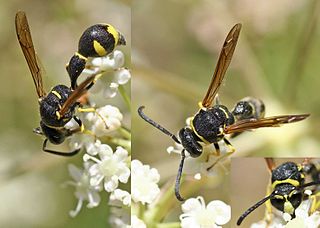
Eumenes is a genus of wasps in the subfamily Eumeninae. It is a large and widespread genus, with over 100 species and subspecies occurring worldwide. The genus was first proposed by Pierre André Latreille in 1802, with the type species later designated by Latreille in 1810. All species make jug-like nests out of mud, usually attached to twigs. The larvae are fed with caterpillars.

The Euparagiinae are a small subfamily of rare wasps in the family Vespidae containing a single extant genus Euparagia. The group had a cosmopolitan distribution in past geological times extending back to the Early Cretaceous, but is now a geographically relict taxon known only from the desert regions of the Southwestern United States and northwestern Mexico.
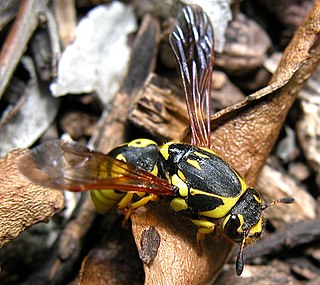
Pseudomasaris is a genus of pollen wasps of the family Vespidae, found in arid regions of western North America. They feed their larvae on the pollen and nectar of a variety of plants, though many species prefer flowers in the genus Phacelia. They are colored black with yellow or white markings that, in a few species, resemble the coloration of yellowjackets.

Megalara garuda, colloquially referred to as the King of Wasps or Garuda wasp, is a large wasp and the only species in the genus Megalara, family Crabronidae, tribe Larrini. The wasp is only known from the Mekongga Mountains in the southeastern part of the Indonesian island of Sulawesi. It was described in 2012 by Lynn Kimsey, director of the Bohart Museum of Entomology and professor of entomology at the University of California, Davis, and Michael Ohl, curator and head of entomology at the Museum für Naturkunde, Berlin. Rosichon Ubaidillah from the Indonesian Institute of Sciences also contributed the discovery.
Lynn Kimsey is an entomologist, taxonomist, director of the Bohart Museum of Entomology and professor of entomology at the University of California, Davis since 1989. Her specialties are bees and wasps; and insect diversity and evolution.

Chrysis is a very large genus of cuckoo wasps. It is the largest genus in the family, including over 1,000 species in over 20 subgenera, as speciose as all remaining Chrysididae combined. The generic name is derived from Greek chrysis, "gold vessel, gold-embroidered dress", and pays tribute to the brilliant metallic appearance of wasps in the genus.

Chrysidini is a very large tribe of cuckoo wasps in the subfamily Chrysidinae; this tribe contains more than half of all chrysidid species.

Pterocheilus is an essentially holarctic genus of potter wasps with a fairly rich diversity in North America and a single Afrotropical species Pterocheilus eurystomus Kohl 1906 known from Socotra. They are usually rather large wasps characterized by reduced tegulae and prominently pilose labial palpi.

Gorytes is a genus of sand wasps in the family Crabronidae. There are at least 70 described species in Gorytes.
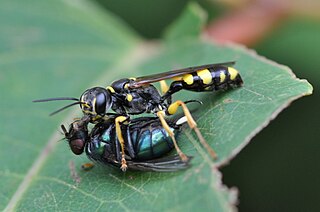
Mellinus is a genus of wasps in the family Mellinidae. The species are found in the Palearctic, Nearctic, the Neotropics and the Orient. 16 species are known
Stictiella is a genus of sand wasps in the family Crabronidae. There are at least 14 described species in Stictiella.
Epinysson is a genus of kleptoparasitic wasps in the family Crabronidae. There are more than 20 described species in Epinysson.

Hoplisoides is a genus of sand wasps in the family Crabronidae. There are at least 70 described species in Hoplisoides.

Myzinum is a genus of wasps in the family Thynnidae. There are 63 species presently recognized in Myzinum. They measure 7–24 mm. They parasitize white grubs, including Phyllophaga. They are used as biological controls.

Parnopes is a genus of cuckoo wasps in the family Chrysididae. The known hosts are in the Crabronidae, subfamily Bembicinae.
Euparagia scutellaris is a species of wasp in the family Vespidae. It is found in the western United States, and larvae feed on weevil larvae.
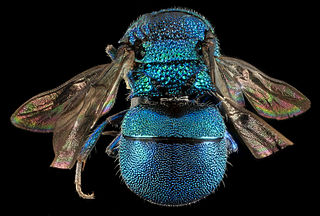
Elampini is a tribe of cuckoo wasps in the family Chrysididae.

Loboscelidiinae is a small subfamily of cuckoo wasps in the family Chrysididae. There are 2 genera and more than 40 described species in Loboscelidiinae, and they are parasitoids of walking stick eggs.
Clypeadon is a genus of wasps belonging to the family Crabronidae.
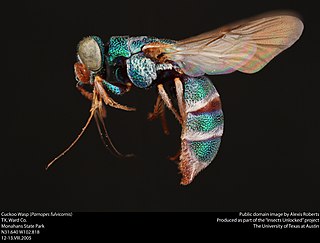
Parnopini is a small tribe of cuckoo wasps in the family Chrysididae. There are 3 genera and about 20 described species in Parnopini; only the hosts of one genus (Parnopes) are known, and they are in the Crabronidae.















